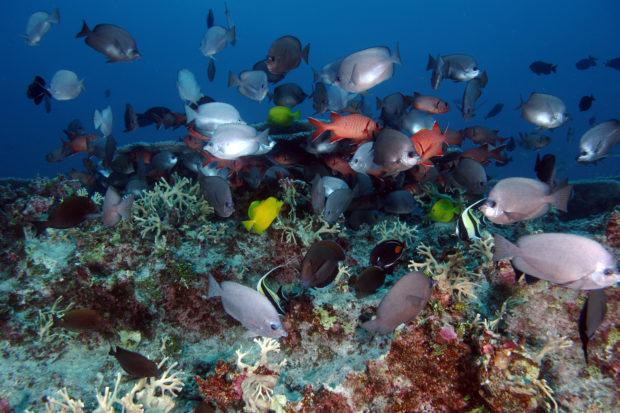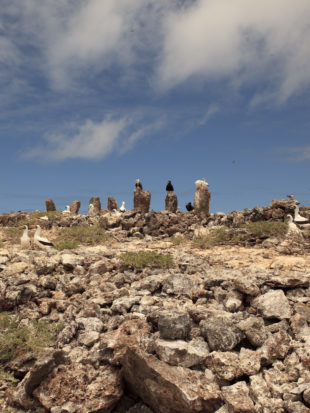Today [8/26], in an exhilarating lead-up to next week’s gathering of dozens of nations at the World Conservation Congress of the International Union for Conservation of Nature, President Obama announced his intention to expand the Papahānaumokuākea Marine National Monument in the Northwest Hawaiian Islands, which will make it the largest marine protected area in the world. President George W. Bush declared Papahānaumokuākea a federal monument in 2006, and in 2010, it became the first mixed UNESCO World Heritage site in the United States.
Today’s action amounts to a vast expansion on the original, excellent idea.

Papahānaumokuākea is home to more than 7,000 marine species, including sharks, whales, turtles, dolphins, monk seals, seabirds, thousands of fish species, and many other animals found nowhere else in the world. Photo by Louiz Rocha
The announcement, which happened thanks to a great assist from U.S. Senator Brian Schatz, will provide quite a statement of leadership as representatives of the IUCN member nations gather in Honolulu – the first time the Congress has been held in the United States in its 60-year history.
Papahānaumokuākea is a vast and isolated linear cluster of small, low lying islands and atolls, and surrounding ocean, roughly 250 km to the northwest of the main Hawaiian Archipelago and extending over some 1,931 km. The area has deep cosmological and traditional importance, as an ancestral environment, as an embodiment of the Native Hawaiian concept of kinship between people and the natural world, and as the place where it is believed that life originates and to which the spirits return after death. On two of the islands, Nihoa and Makumanamana, there are archaeological remains relating to pre-European settlement and use.

On two of the islands, Nihoa and Makumanamana (pictured above), there are sacred sites and archaeological remains. Photo by Andy Collins/NOAA
Much of the monument is made up of pelagic and deepwater habitats, with notable features such as seamounts and submerged banks, extensive coral reefs, and lagoons. The monument is home to more than 7,000 marine species, including sharks, whales, turtles, dolphins, monk seals, seabirds, thousands of fish species, and many other animals found nowhere else in the world. Scientists recently discovered the oldest living coral, estimated to be 4,600 years old, the largest sea sponge (the size of an SUV), and a new species of octopus referred to as “Casper” for his translucent, white, ghost-like appearance.
Scientists estimate that a minimum of 30 percent of our world’s oceans must be protected just to mitigate the effects of climate change, but currently less than five percent are protected. Further, our oceans face new, destructive industries such as ocean mining, and the continued impacts of industrialized commercial fisheries where, in Hawaii alone, more than 10,000 marine animals, primarily sharks, become victims of bycatch every year. Banning commercial fishing in this vast area has tremendous regenerative potential for our oceans and for all marine life, and will save a lot of lives.
We commend President Obama, Senator Schatz and the thousands of policymakers, organizations, and Hawaii residents who have been part of this remarkable ocean protection initiative.
P.S. This was a remarkable week for the President, who is seeking to cement his environmental legacy in the very week that the United States celebrated the 100th anniversary of the National Park Service. Using his authority under the Antiquities Act, President Obama also designated more than 87,500 acres of Maine lands, donated by a founder of the Burt’s Bees natural care products company, as the Katahdin Woods and Waters National Monument, to be administered by the NPS. This approach falls short of what some activists want, and amounts to a transfer of Roxanne Quimby’s private land holding to the National Park Service, yet it’s an important protection. While bear hunting will be prohibited, some forms of hunting will be allowed, which is an adverse precedent for national monuments. Nonetheless, it is a move we celebrate, one that protects a vast territory of significant wildlife habitat and natural areas in the American Northeast. Much of this land abuts Baxter State Park, created through the largesse and wisdom of one of the early 20th century’s greatest animal advocates, Governor Percival Baxter.
P.S.S. I couldn’t help but link the president’s actions under the Antiquities Act to protect these natural areas with another bit of news from Hawaii: the announcement by the National Marine Fisheries Service that it would prohibit swimming with or approaching within 50 yards of Hawaiian spinner dolphins. Such interactions are stressful to the animals and we need to exercise greater restraint, given the evidence now available. We’re in a struggle to save the planet, its ecosystems, and its nonhuman inhabitants, as well as ourselves. What could be more important than these kinds of actions that promise to protect both habitat and imperiled species in a broader interest?
The post A wild name, and an amazing, vast, new marine sanctuary appeared first on A Humane Nation.
Enviroshop is maintained by dedicated NetSys Interactive Inc. owners & employees who generously contribute their time to maintenance & editing, web design, custom programming, & website hosting for Enviroshop.
